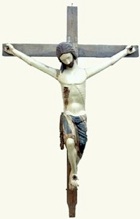

Medieval Gates (1242)
The present walls of Gualdo Tadino were built by the Emperor Frederick II in 1242. Two of its original gates survive: the others were: Porta San Martino; and Porta San Facondino.
Porta San Benedetto
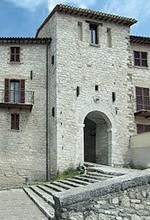
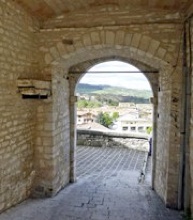

Porta di San Benedetto, regnando Federico Imperatore,
nel mese quarto dell' anno del Signore MDCCXLII
recording the construction of the gate (and the rest of the city walls) by the Emperor Frederick II in April 1242.
Porta San Donato
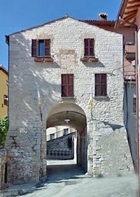
Sant’ Agostino (demolished)
This church and convent were documented in 1288.
The church was reconstructed after the earthquake of 1612 and had to be comprehensively restored after the earthquake of 1751.
The convent was suppressed in 1860. An orphanage that was established here was moved here from the ex-Monastero di San Nicolò (below) in 1912.
The church was deconsecrated in 1922, when its altars were moved to San Donato. the complex was subsequently demolished.
Crucifix (14th century)
SS Augustine and Catherine of Alexandria (16th century)
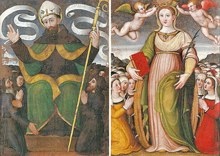
These two small canvases in the Pinacoteca Comunale almost certainly came from Sant’ Agostino, the seat of the Confraternita di SS Agostino e Caterina, and were probably used in processions by the confraternity. The canvases, which are attributed to Luca Nucci, depict:
-
✴St Augustine enthroned, with members of the confraternity; and
-
✴the standing St Catherine crowned by putti, with female associate members of the confraternity.
Doors (Date?)
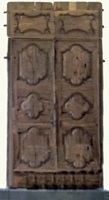
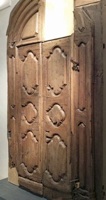
These two doors from Sant’ Agostino are now in the Pinacoteca Comunale.
Sant’ Ippolito (ca. 1670)
This tiny church was built by two priests from Gualdo, Girolamo and Carlo Mannelli, and remained in the ownership of that family until the late 18th century. An earlier church had been documented on or near the site in the 15th century. It subsequently passed, in turn, to the Coppari, Calai and Sinibaldi families.
Madonna and Child with saints (ca. 1668)

Santa Maria del Piano (1663-6)
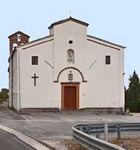
Bishop Giovanni Battista Chiappé consecrated the church in 1730. It needed extensive restoration after the earthquake of 1751 and was subordinated to San Giovanni Laterano, Rome in 1767.
Santa Maria del Purgo (1647)
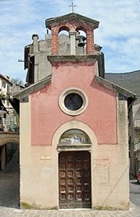
Santa Maria di Rote (1647, rebuilt in 1927)
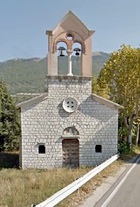
The first civic cemetery of Gualdo Tadino was established beside this church during a cholera epidemic in 1855. This cemetery closed when the new one was opened at San Facundino in 1890. The bones from the old cemetery were interred in a common grave under the pavement of the church in 1923, and the Commune rebuilt church itself in 1927 to provide a decent environment for them.
Santa Maria di Tadino (1240s)
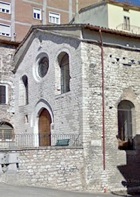

The Confraternita di Santa Maria dei Raccomandati built an adjacent hospice in 1373.
The complex passed to the nuns of Santa Chiara in 1567.
San Nicolò (demolished)
This church of San Nicolò was first documented in 1468, albeit that it was probably well-established by that time. A Sylvestrine monastery was established next to it in 1614. The Commune granted the tower above Porta San Donato (above) to the monks of San Nicolò in the 1790s so that they could extend their monastery.
The Sylvestrine community was suppressed in 1860. An orphanage was moved here from the ex-Convento di Sant‘ Agostino (above) in 1912, at which point the church was closed. [The complex was subsequently demolished.]
Madonna and Child with saints (1471)
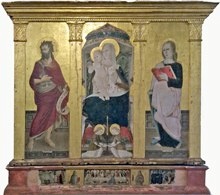
This altarpiece in the Pinacoteca Comunale, which is signed by Matteo da Gualdo and dated by inscription, was documented in San Nicolò in 1871, as it was about to enter the civic collection. Its original location is unknown. It depicts Madonna and Child with angels and SS John the Baptist and John the Evangelist. The predella panels depict:
-
✴the Baptism of Christ by St John the Baptist;
-
✴the Last Supper; and
-
✴St John the Evangelist raising the widow Drusiana from the dead.
Madonna and Child with saints (17th century)
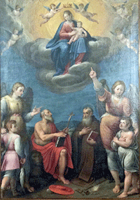
Holy House of Loreto with saints (17th century)
This documented but now-lost altarpiece of the Holy House of Loreto with SS Nicholas of Bari and Charles Borromeo from the high altar has recently been attributed to Avanzino Nucci.
San Rocco (1476)
This tiny semi-circular church was built using donations by two survivors of the epidemic of plague that hit the surrounding area in 1476.
When the Erermo di San Marzio collapsed in ca. 1600, the relics of the Blessed Martius were moved to the nearby tiny church of Sant’ Anna. When this church also collapsed in 1608, the relics were moved again to San Rocco. In 1766, at which time San Rocco was administered by the commendatory abbot of San Donato, this abbot opposed a request by the friars of San Francesco to move the relics to their church. They thwarted his intention to translate them to San Donato by taking them, without authorisation, to their church.
Frescoes (15th century)
The walls of the church were originally covered in votive frescoes. The few fragments that survive include the following that are attributed to Matteo da Gualdo:
-
✴the Madonna and Child enthroned, in which the baby Jesus holds a bunch of grapes; and
-
✴the Madonna and Child and St Sebastian.
Return to Monuments of Gubbio.
Return to Walk around Gualdo Tadino (for all monument except those below), or
Excursions from Gualdo Tadino (Sant’ Ippolito ; Santa Maria del Piano;
Santa Maria di Rote; San Rocco)
